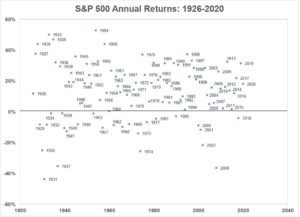From 1926 to 2020, the average return for the U.S. stock market was basically 10% per year. Not too shabby. A 10% annual return over 30 years will produce extraordinary results. The worst 30-year rolling return during this time period was 8% from 1929-1958. The total return for an 8% annual return over 30 years is 900%. Pretty decent for the worst result ever.

So, why doesn’t everyone just clock in, take their returns, and go home wealthy? I assume that is what would happen if you could consistently rely on 10% returns every year. Unfortunately, that’s not how it works. While 10% is the long-term average, the actual yearly market returns are anything but average.
This is a quality that both LeBron James and the stock market share. Yes, that LeBron James. He’s one of the greatest basketball players of all time (although he’s probably going to get bounced in this year’s playoffs by the Jazz) and has accomplished almost everything that there is to accomplish in basketball. However, there is one thing that still eludes him.
Lebron is known for his consistency. Every season throughout his 17-year career he’s hovered around his career averages of 27 points, 7 rebounds, and 7 assists. Yet in over 1,300 games played, he’s never recorded a 27-7-7 stat line. Not once.

A similar phenomenon happens in the stock market. However, unlike Lebron James, the stock market isn’t nearly as consistent. It does not hover around its long-term average year to year.
The chart below maps out the yearly returns of the S&P 500 and shows just how volatile it is each year:

Good luck trying to predict what’s going to happen next. The stock market produces wildly different returns each year.
In fact, calendar year returns plus or minus 2% from the 10% long-term average (so 8% to 12%) have happened in just 5 calendar years. So only about 5% of all years since 1926 have seen average returns.
The thing is, if market returns were consistent there would be no risk. Everyone would do it. And if there was no risk to investing in the stock market then there would be no opportunity for a return. You can’t have one without the other.

The only way to take some of the uncertainty out of investing is to have a long time horizon. The longer you invest, the closer you’ll get to the long-term average. The annual returns for any number of non-overlapping 30-year periods are solid. Here are a few examples:
- 1926-1955: 9.7%
- 1956-1985: 9.4%
- 1986-2015: 10.3%
Or:
- 1931-1960: 9.8%
- 1961-1990: 10.1%
- 1991-2020: 10.6%
Now, who knows if the next 95 years will be as good to investors as the last 95. A tenet of investing is that past performance does not guarantee future results. You can never truly escape risk.
Those who achieve the average long-term returns are those who invest for a long time. Simple as that. But it’s never been easier to pay attention to, and panic over, short-term market movements. Still, if you want high returns over the long haul you’ll have to accept volatility.
Short-term uncertainty is the price to pay for long-term investing success.
Thanks for reading!

